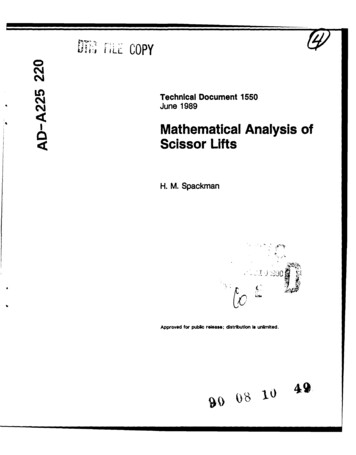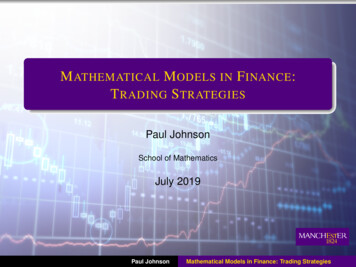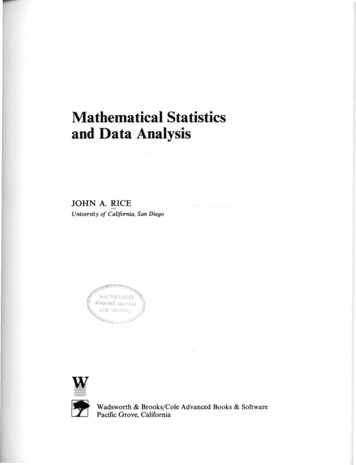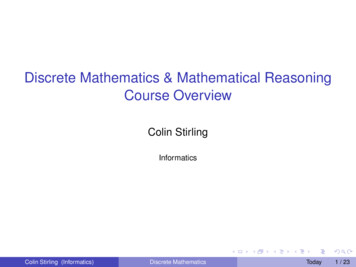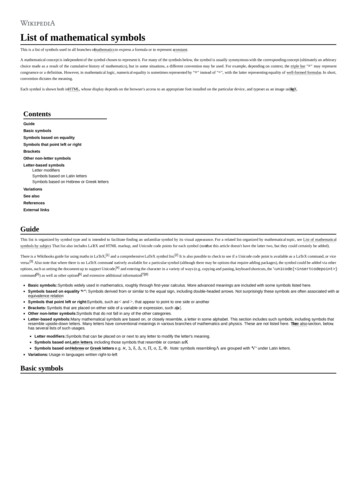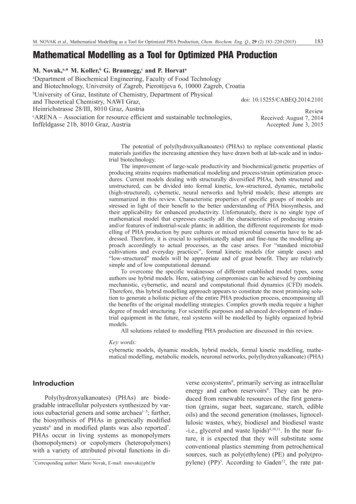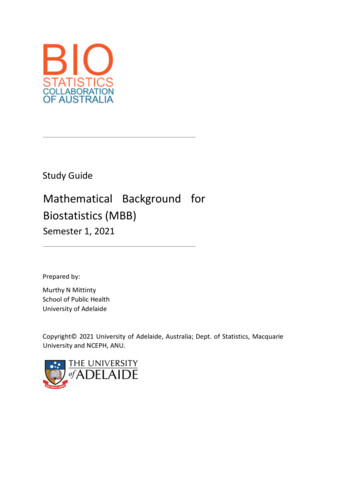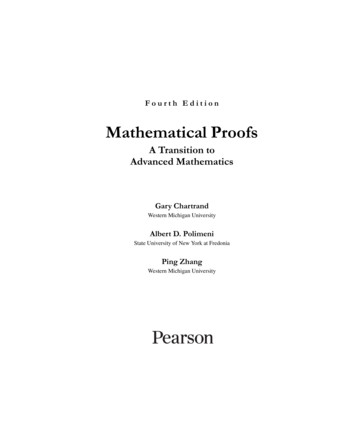
Transcription
P1: OSO/OVYP2: OSO/OVYA01 CHART6753 04 SE FMQC: OSO/OVYPH03348-ChartrandT1: OSOSeptember 22, 20178:50Char Count 0Fourth EditionMathematical ProofsA Transition toAdvanced MathematicsGary ChartrandWestern Michigan UniversityAlbert D. PolimeniState University of New York at FredoniaPing ZhangWestern Michigan Universityi
C 2018, 2013, 2008 by Pearson Education, Inc.Copyright Library of Congress Cataloging-in-Publication DataNames: Chartrand, Gary, author. Polimeni, Albert D., 1938- author. Zhang, Ping, 1957- author.Title: Mathematical proofs : a transition to advanced mathematics / Gary Chartrand,Western Michigan University, Albert D. Polimeni, State University of New York at Fredonia,Ping Zhang, Western Michigan University.Description: Fourth edition. Boston : Pearson, [2018] Includes bibliographical referencesand index.Identifiers: LCCN 2017024934 ISBN 9780134746753 ISBN 0134746759Subjects: LCSH: Proof theory–Textbooks.Classification: LCC QA9.54 .C48 2018 DDC 511.3/6–dc23 LC record available athttps://lccn.loc.gov/2017024934ISBN-13: 978-0-13-474675-3ISBN-10:0-13-474675-9ii
P1: OSO/OVYP2: OSO/OVYA01 CHART6753 04 SE FMQC: OSO/OVYPH03348-ChartrandT1: OSOSeptember 22, 20178:50Char Count 0Contents0Communicating Mathematics0.10.20.30.40.50.60.71Learning Mathematics2What Others Have Said About Writing3Mathematical Writing5Using Symbols6Writing Mathematical Expressions8Common Words and Phrases in Mathematics10Some Closing Comments About Writing12Sets1.1 Describing a Set141.2 Subsets181.3 Set Operations231.4 Indexed Collections of Sets1.5 Partitions of Sets311.6 Cartesian Products of SetsChapter 1 Supplemental Exercises2114273335Logic2.1 Statements382.2 Negations412.3 Disjunctions and Conjunctions432.4 Implications452.5 More on Implications492.6 Biconditionals532.7 Tautologies and Contradictions572.8 Logical Equivalence602.9 Some Fundamental Properties of Logical Equivalence2.10 Quantified Statements652.11 Characterizations76Chapter 2 Supplemental Exercises783862
3Direct Proof and Proof by Contrapositive3.1 Trivial and Vacuous Proofs3.2 Direct Proofs853.3 Proof by Contrapositive3.4 Proof by Cases943.5 Proof Evaluations98Chapter 3 Supplemental Exercises4818289102More on Direct Proof and Proof by Contrapositive1054.1 Proofs Involving Divisibility of Integers1054.2 Proofs Involving Congruence of Integers1104.3 Proofs Involving Real Numbers1134.4 Proofs Involving Sets1174.5 Fundamental Properties of Set Operations1204.6 Proofs Involving Cartesian Products of Sets122Chapter 4 Supplemental Exercises1235Existence and Proof by Contradiction1275.1 Counterexamples1275.2 Proof by Contradiction1315.3 A Review of Three Proof Techniques1385.4 Existence Proofs1415.5 Disproving Existence Statements146Chapter 5 Supplemental Exercises1496Mathematical Induction1526.1 The Principle of Mathematical Induction1526.2 A More General Principle of Mathematical Induction1626.3 The Strong Principle of Mathematical Induction1706.4 Proof by Minimum Counterexample174Chapter 6 Supplemental Exercises1787Reviewing Proof Techniques7.1 Reviewing Direct Proof and Proof by Contrapositive1827.2 Reviewing Proof by Contradiction and Existence Proofs1857.3 Reviewing Induction Proofs1887.4 Reviewing Evaluations of Proposed Proofs189Exercises for Chapter 7193181
8Prove or Disprove2008.1 Conjectures in Mathematics2008.2 Revisiting Quantified Statements2058.3 Testing Statements211Chapter 8 Supplemental Exercises2209Equivalence Relations9.1 Relations2249.2 Properties of Relations2269.3 Equivalence Relations2309.4 Properties of Equivalence Classes9.5 Congruence Modulo n2399.6 The Integers Modulo n245Chapter 9 Supplemental Exercises24810224235Functions25110.1 The Definition of Function25110.2 One-to-one and Onto Functions25610.3 Bijective Functions25910.4 Composition of Functions26310.5 Inverse Functions267Chapter 10 Supplemental Exercises27411Cardinalities of Sets27811.1 Numerically Equivalent Sets27911.2 Denumerable Sets28011.3 Uncountable Sets28811.4 Comparing Cardinalities of Sets29311.5 The Schröder-Bernstein Theorem296Chapter 11 Supplemental Exercises30112Proofs in Number Theory12.112.212.312.412.5Divisibility Properties of Integers303The Division Algorithm305Greatest Common Divisors310The Euclidean Algorithm312Relatively Prime Integers315303
12.6 The Fundamental Theorem of Arithmetic31812.7 Concepts Involving Sums of Divisors322Chapter 12 Supplemental Exercises32413Proofs in Combinatorics32713.1 The Multiplication and Addition Principles32713.2 The Principle of Inclusion-Exclusion33313.3 The Pigeonhole Principle33613.4 Permutations and Combinations34013.5 The Pascal Triangle34813.6 The Binomial Theorem35213.7 Permutations and Combinations with Repetition357Chapter 13 Supplemental Exercises36314Proofs in Calculus36514.1 Limits of Sequences36514.2 Infinite Series37314.3 Limits of Functions37814.4 Fundamental Properties of Limits of Functions14.5 Continuity39214.6 Differentiability395Chapter 14 Supplemental Exercises39715Proofs in Group Theory15.1 Binary Operations40015.2 Groups40515.3 Permutation Groups41115.4 Fundamental Properties of Groups15.5 Subgroups41815.6 Isomorphic Groups423Chapter 15 Supplemental Exercises42816Proofs in Ring Theory(Online at goo.gl/zKdQor)16.1 Rings16.2 Elementary Properties of Rings16.3 Subrings16.4 Integral Domains16.5 FieldsExercises for Chapter 16386400414
171819Proofs in Linear Algebra(Online at goo.gl/Tmh2ZB)17.1 Properties of Vectors in 3-Space17.2 Vector Spaces17.3 Matrices17.4 Some Properties of Vector Spaces17.5 Subspaces17.6 Spans of Vectors17.7 Linear Dependence and Independence17.8 Linear Transformations17.9 Properties of Linear TransformationsExercises for Chapter 17Proofs with Real and Complex Numbers(Online at goo.gl/ymv5kJ)18.1 The Real Numbers as an Ordered Field18.2 The Real Numbers and the Completeness Axiom18.3 Open and Closed Sets of Real Numbers18.4 Compact Sets of Real Numbers18.5 Complex Numbers18.6 De Moivre’s Theorem and Euler’s FormulaExercises for Chapter 18Proofs in Topology(Online at goo.gl/bWFRMu)19.1 Metric Spaces19.2 Open Sets in Metric Spaces19.3 Continuity in Metric Spaces19.4 Topological Spaces19.5 Continuity in Topological SpacesExercises for Chapter 19Answers and Hints to Selected Odd-NumberedExercises in Chapters 16–19 (online at goo.gl/uPLFfs)Answers to Odd-Numbered Section ExercisesReferencesCreditsIndex of SymbolsIndex430483484486487
P1: OSO/OVYP2: OSO/OVYA01 CHART6753 04 SE FMQC: OSO/OVYPH03348-ChartrandT1: OSOSeptember 22, 20178:50Char Count 0Preface to the Fourth EditionAs the teaching of calculus in many colleges and universities has become more problemoriented with added emphasis on the use of calculators and computers, the theoreticalgap between the material presented in calculus and the mathematical backgroundexpected (or at least hoped for) in advanced calculus and other more advanced courseshas widened. In an attempt to narrow this gap and to better prepare students for themore abstract mathematics courses to follow, many colleges and universities haveintroduced courses that are now commonly called “transition courses.” In these courses,students are introduced to problems whose solution involves mathematical reasoningand a knowledge of proof techniques, where writing clear proofs is emphasized. Topicssuch as relations, functions and cardinalities of sets are encountered throughout theoretical mathematics courses. Lastly, transition courses often include theoretical aspectsof number theory, combinatorics, abstract algebra and calculus. This textbook has beenwritten for such a course.The idea for this textbook originated in the early 1980s, long before transitioncourses became fashionable, during the supervision of undergraduate mathematics research projects. We came to realize that even advanced undergraduates lack a soundunderstanding of proof techniques and have difficulty writing correct and clear proofs.At that time, we developed a set of notes for these students. This was followed by theintroduction of a transition course, for which a more detailed set of notes was written.The first edition of this book emanated from these notes, which in turn has ultimatelyled to this fourth edition.While understanding proofs and proof techniques and writing good proofs are majorgoals here, these are not things that can be accomplished to any great degree in a singlecourse during a single semester. These must continue to be emphasized and practiced insucceeding mathematics courses.Our ApproachSince this textbook originated from notes that were written exclusively for undergraduates to help them understand proof techniques and to write good proofs, the tone isstudent-friendly. Numerous examples of proofs are presented in the text. Following common practice, we indicate the end of a proof with the square symbol . Often we precedea proof by a discussion, referred to as a proof strategy, where we think through whatis needed to present a proof of the result in question. Other times, we find it useful toreflect on a proof we have just presented to point out certain key details. We refer to adiscussion of this type as a proof analysis. Periodically, we present and solve problems,and we may find it convenient to discuss some features of the solution, which we refer to
simply as an analysis. For clarity, we indicate the end of a discussion of a proof strategy,proof analysis, analysis, or solution of an example with the diamond symbol .A major goal of this textbook is to help students learn to construct proofs of theirown that are not only mathematically correct but clearly written. More advanced mathematics students should strive to present proofs that are convincing, readable, notationallyconsistent and grammatically correct. A secondary goal is to have students gain sufficient knowledge of and confidence with proofs so that they will recognize, understandand appreciate a proof that is properly written.As with the first three editions, the fourth edition of this book is intended to assistthe student in making the transition to courses that rely more on mathematical proof andreasoning. We envision that students taking a course based on this book have probablyhad a year of calculus (and possibly another course such as elementary linear algebra)although no specific prerequisite mathematics courses are required. It is likely that, priorto taking this course, a student’s training in mathematics consisted primarily of doingpatterned problems; that is, students have been taught methods for solving problems,likely including some explanation as to why these methods worked. Students may verywell have had exposure to some proofs in earlier courses but, more than likely, wereunaware of the logic involved and of the method of proof being used. There may haveeven been times when the students were not certain what was being proved.New to This EditionThe following changes and additions to the third edition have resulted in this fourthedition of the text: Presentation slides in PDF and LaTeX formats have been created to accompanyevery chapter. These presentations provide examples and exposition on key topics.Using short URLs (which are called out in the margin using theicon), thesepresentations are linked in the text beside the supplemental exercises at the end ofeach chapter. These slides can be used by instructors in lecture, or by students tolearn and review key ideas. The new Chapter 7, “Reviewing Proof Techniques,” summarizes all the techniquesthat have been presented. The placement of this chapter allows instructors andstudents to review all of these techniques before beginning to explore differentcontexts in which proofs are used. This new chapter includes many new examplesand exercises. The new Chapter 13, “Proofs in Combinatorics,” has been added because of ademand for such a chapter. Here, results and examples are presented in thisimportant area of discrete mathematics. Numerous exercises are also included inthis chapter. The new online Chapter 18, “Proofs with Real and Complex Numbers,” has beenadded to provide information on these two important classes of numbers. Thischapter includes many important classical results on real numbers as well asimportant results from complex variables. In each case, detailed proofs are given.
Chapters 16 (Proofs in Ring Theory), 17 (Proofs in Linear Algebra), and 19 (Proofsin Topology) continue to exist online to allow faculty to tailor the course to meettheir specific needs. More than 250 exercises have been added. Many of the new exercises fall into themoderate difficulty level and require more thought to solve. Section exercises for each chapter have been moved from the end of the chapter tothe end of each section within a chapter. (Exceptions: for the review chapter [7] andthe online chapters [16–19], all exercises remain at the end of the chapter.) In the previous edition, there were exercises at the end of each chapter calledAdditional Exercises. These summative exercises served to pull together the ideasfrom the various sections of the chapter. These exercises remain at the end of thechapters in this edition, but they have been renamed Supplemental Exercises.Contents and StructureOutline of ContentsEach of the Chapters 1–6 and 8–15 is divided into sections, and exercises for each sectionoccur at the end of that section. There is also a final supplemental section of exercisesfor the entire chapter appearing at the end of that chapter.Since writing good proofs requires a certain degree of competence in writing, wehave devoted Chapter 0 to writing mathematics. The emphasis of this chapter is on effective and clear exposition, correct usage of symbols, writing and displaying mathematicalexpressions, and using key words and phrases. Although every instructor will emphasize writing in his or her own way, we feel that it is useful to read Chapter 0 periodicallythroughout the course. It will mean more as the student progresses through the course.
Four additional chapters, Chapters 16–19 (dealing with proofs in ring theory, linear algebra, real and complex numbers, and topology), can be found by going to: goo.gl/bf2Nb3. Instructor’s Solutions Manual (downloadable) ISBN-10:0134840461—ISBN-13:9780134840468 rs,providesworked-outsolutions
